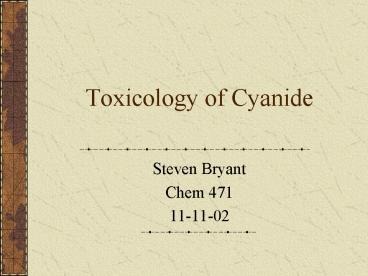Toxicology of Cyanide PowerPoint PPT Presentation
1 / 19
Title: Toxicology of Cyanide
1
Toxicology of Cyanide
- Steven Bryant
- Chem 471
- 11-11-02
2
Outline of Presentation
- History of Cyanide
- General toxicity
- Mechanisms
- Antidotes
- Status of cyanide
3
History of Cyanide
- Affects on biological organisms studied for
nearly 200 years - A German pharmacist, Schrader, noticed that
hydrogen cyanide (HCN) was released when leaves
of the cherry laurel and other rosaceous species
were crushed - Became a highly researched toxin in industry due
to its frequent use in mining and metallurgy
4
Non-Industrial Sources
- Found in some foods and plants almonds, millet
sprouts, lima beans, bamboo shoots, cassava roots
(tapioca), spinach, and soy - Vitamin B12 is another source of cyanide, where
it occurs as a part of the naturally occurring
sugars or other complex organic compounds - Other non-industrial sources of cyanide exposure
burning of leaves or other yard waste, and from
smoking cigarettes
5
Industrial Sources
- Industry major source of cyanide in soil and
water - Sources of cyanide in water metal mining
processes, organic chemical industries, publicly
owned wastewater treatment plants, and iron and
steel plants - Gaseous sources of cyanide fumes of certain
chemical industries, vehicle exhaust, and waste
burning
6
- Most common industrial forms of cyanide in the
environment hydrogen cyanide, sodium cyanide,
and potassium cyanide - Cyanide salts and hydrogen cyanide are often used
in metallurgy, photographic development, making
plastics, fumigating ships, pesticides, and
electroplating - Cyanide contamination of the water/soil can be
contributed to the use of certain road salts, as
well as landfills
7
Toxicity Regulations
- Government organizations, as well as worldwide
organizations, have set recommended exposure
levels - EPA
- Amount of cyanide allowed in water is 200
micrograms per liter of water. - Limits of hydrogen cyanide stored in foods 5
parts per million (ppm) for certain vegetables -
250 ppm in some spices
8
- EPA also sets spill regulations
- OSHA
- Permissible exposure limit for cyanide salts is 5
mg of cyanide per cubic meter of air averaged
over an 8-hour workday or 40-hour workweek - NIOSH
- Recommended exposure levels of 5 mg/m3 for 10
minutes for workers when exposed to calcium
cyanide, hydrogen cyanide, potassium cyanide, and
sodium cyanide.
9
Routes of Exposure
- Routes inhalation, oral, or dermal exposure
- Once cyanide is absorbed, it is rapidly
transported through the blood - In the lungs, it can be distributed to the body
within seconds and death can occur in minutes - Oral Rapidly absorbed from the gastrointestinal
tract - Does not accumulate in tissue/blood in chronic
exposure cases
10
Effects on the Body
- Cyanide can affect vascular, pulmonary, central
nervous, cardiac, visual, autonomic, endocrine,
and metabolic systems - Vascular system An initial transient increase,
then a decrease in cardiac output - Visual system A loss in the capacity to focus
- Pulmonary system Respiratory gasp caused by the
stimulation of a chemoreceptor, followed by
hyperventilation - Central nervous system Decrease in awareness
that can be followed by convulsions or loss of
consciousness - Metabolic system Decrease in energy production
by the inhibition of the use of cytochrome oxidase
11
Metabolic System Affects
- Blocking of the formation of adenosine
triphosphate (ATP) - ATP Immediate energy source for doing work in
biological systems - Blocking of ATP occurs when cyanide and carbon
monoxide block the final step of electron
transfer from cytochrome oxidase to oxygen.
Electron flow and respiration are stimulated, but
short-circuiting the proton current prevent ATP
formation.4
12
Metabolism of Cyanide
13
Mechanism of Toxicity
- Two-step process
- First, HCN penetrates a protein crevice of
cytochrome c oxidase and binds to the protein - Then, the hydrogen cyanide binds to the trivalent
iron ion of the enzyme, forming a relatively
stable, but reversible, coordination complex - Results increased blood glucose, pyruvic acid,
lactic acid and nicotinamide adenine dinucleotide
(NADPH) levels, and a decrease in the
ATP/adenosine diphosphate (ADP) ratio.2
14
Mechanism of Toxicity
- Acts as a strong nucleophile having multiple
effects on the body - In the neurons, there is an accumulation of
intracellular calcium due to the cyanide
nucleophile. - Initiate the release of catecholamines from the
adrenals and adrenergic nerve terminals. 5 - Release of excitatory neurotransmitters in the
brain, inhibits the enzymes that protect the
brain against oxidation energy - The mitochondrial cytochrome c oxidase inhibition
mechanism, discussed above, also causes central
nervous system damage.
15
Preferred Mechanism
- Not all metabolized products are bad
- Thiocyanate (SCN-), a far less toxic metabolite
- CN- S2O3-2 ? SCN- SO3-2
- More desirable and less toxic in the body, unlike
the other cyanide products that are formed in the
body
16
Another Preferred Mechanism
- Amino acid cystine plays role in the safe removal
- Cystine and cyanide combine to form
thiocyanoalanine
17
Antidotes
- Methylene blue
- Produces methemoglobin, which binds the cyanide
ion and prevents damage of the respiratory
enzymes - Amyl nitrite and sodium
- Much more effective in forming methemoglobin.5
- Found in Lilly cyanide kit
18
Current Status
- Currently, cyanide is being produced from, as
well as used in, industry - It is still comes from yard waste burning,
cigarette smoking, car exhaust, and many other
sources - EPA and OSHA try to keep these levels lower and
safer for citizens and workers in industry - Some cities limit yard waste burning to minimize
pollutants
19
References
- Conn, E.E et. al., Cyanide Compounds in
Biology, John Wiley and Sons, Chichester, 1988. - Harper, Carolyn Goldhaber, Susan. Toxicological
Profile for Cyanide (Update). Research Triangle
Institute, Atlanta, 1997. - http//www.atsdr.cdc.gov/tfacts8.html. Accessed
9/23/02. Last update June 11, 2001. - Baskin, Steven I. Brewer, Thomas J. Medical
Aspects of Chemical and Biological Warfare.
Borden Institute, 1997. - Arena, Jay M., Poisoning Toxicology..Symptoms..Tr
eatments. Bannerstone House, Springfield, 1974. - Elkins, Harvey B. Industrial Toxicology. John
Wiley and Sons, New York, 1950.

